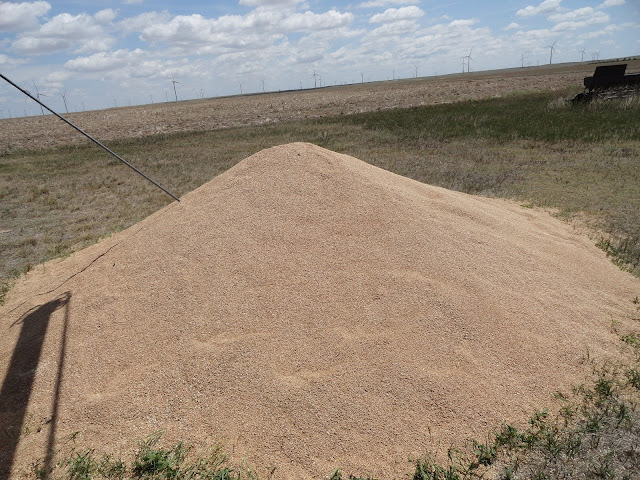The place looked dead. I pulled into the driveway anyway.
“It’s closed,”
the Goodwife said.
“It can’t
be. It’s Friday. Nobody died.”
I pulled up to the drive-up window.
The shade was pulled, the slats closed.
In the window hung a sign: “Closed
Friday at noon to go to the fair.”
“What? The fair was last week. At least I thought it was.” And there it began.
The menu included
hamburgers and hot dogs, cottage fries, maybe a salad, with watermelon for
dessert. We were carrying most of the stuff we needed in the car with us. All that went by the
wayside. Before we could get a hundred
yards from the bank’s drive-up window, the Goodwife had the daughter on the
phone.
“Hey, the fair's
going on in Hugo! The kids would enjoy
seeing that.”
We all met at the farm.
By 5:30, we were wandering the Lincoln County fairgrounds. I headed for the buffalo burger booth. That was my favorite fair place. Eventually, we would all get there and place
our orders.
We kept our
distance from everybody as we waited for our orders to fill. Grandson wandered toward the arena where he
could watch horses and folks wandering around.
We sat at a table long enough to eat, and then we wandered back to the
arena.
They weren’t
charging admission, so we hiked our way to the top of the grandstand to take in
the rodeo. The kids’ portion of the day
was winding down. At 6:30, the kids were
summoned for the mutton bustin’ event.
The rodeo was scheduled for 7:00.
Grandson was
wandering up and down the grandstand stairs and checking into all the things he
could see. When the first ewe broke out
of the chute and a helmeted and vested kid went for a tumble off her back to a
landing in the loose soil of the arena, his attention never strayed from the
action around the gate until the last kid tried his luck at staying on the
sheep’s back.
Grandson was
pretty sure he could do that. He was
pretty sure he could stay on a lot longer than the ones we had witnessed. When he realized that the event would be
repeated the next day, there was nothing for it but we come back and get him
entered.
Somehow, we
learned that only 15 kids were allowed to ride in the Mutton bustin’. So, I began to soften Grandson up so he
wouldn’t be disappointed if he wasn’t one of the big 15. Not a possibility. He would ride and he would win the medal.
We went to the restroom. Grandson struck up a conversation with a man
washing his hands as he waited for me to finish my business. He was going to ride the sheep tomorrow and
he was going to win.
“Gonna do the mutton
bustin’?” the man asked.
“What?”
“That’s what
they call it, mutton bustin’,” I explained.
“Yeah, and I’m
gonna win!”
“Go for it,
cowboy!” the man said as he walked out.
We watched most
of the rodeo. We left during the bull
riding. I said to Grandson, “If you don’t
get to ride the sheep, shall we see if we can get you signed up for the bull
riding?”
“Hell no!” he said. He got a severe lecture from his mama. It was inappropriate for a six-year-old, but
it was entirely appropriate, too. He’s
no dummy, maybe.
Other difficulties
arose. Swimming had been the main
agenda, until the fair invaded. He didn’t
bring his cowboy boots, only crocks. He
didn’t have any jeans. After a search
for boots came up empty, it was determined he would get along fine with his
crocks and his long pants.
Saturday morning
found us headed to Hugo again. We had to
be there by 11:30 to sign up for 12:30 Mutton Bustin’. We got there for the tail end of the parade
that started at 10. We were in plenty of
time to sign up.
It turned out
that about 18 kids signed up, so rather than disappoint three kids, they
arranged to recycle a few sheep and let everybody ride. Grandson was about number 12 or so, a ways
back in the lineup.
Some kids came
back crying after they fell off the ewe.
Even though the dirt was stirred up, deep and soft, falling can still be
painful and sometimes the ewe steps on a
fallen rider. Grandson was not deterred
to see a would-be rider come back sobbing.
His enthusiasm and resolve remained strong throughout.
On went the
helmet and the flak jacket.
And then, it was his turn.
And then, the reward. Or award?
Things slowed down a little. The swimming pool has two sessions, a 1-to-3 p.m. session, and a 3:30-to-5 p.m. session. They missed the early session, so we watched the rodeo again to kill time. They went swimming when the time came. Swimming was fine, but it couldn’t compete with mutton bustin’.
Grandson already checked it out. He can keep mutton bustin’ until he is 8.
He plans to be back next year.
(If you can't run the video, email me & I will send.)














